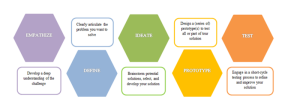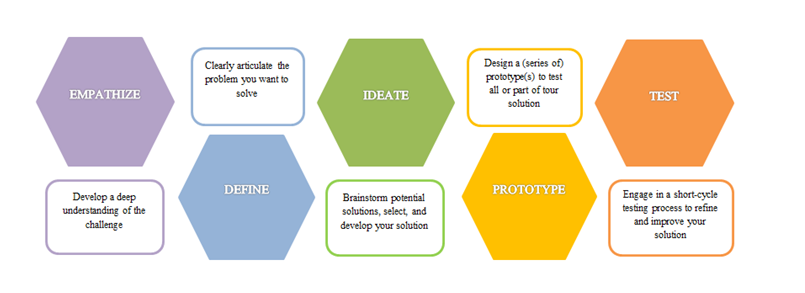Design thinking
Design thinking is a special approach which relies on the human ability to be intuitive, to recognize patterns and to construct ideas that are emotionally meaningful as well as functional. The elements of design thinking combine to form an iterative approach—one you can try out and adapt to suit your needs.
Design thinking is relatively new, innovative approach in Theory of management and other fields of work. As Charles L. Owen had mentioned in his work "Design Thinking: Driving Innovation": " Innovation, a critical factor in business competition, is a more complex concept than many realize. Far more than principles, rules and procedures, it is a process most effective when imbued with attitudes and ways of thinking that have evolved over generations within the community of those who routinely practice creative invention and synthesis. Significant among these are ways of thinking from the design fields appropriately referred to as "design thinking"."
Contents
- 1 Examples of Design thinking
- 2 Stages of design thinking
- 3 Advantages of Design thinking
- 4 Limitations of Design thinking
- 5 Other approaches related to Design thinking
- 6 References
Examples of Design thinking
Some examples of design thinking approach:
- Zero-step entryways into a home or building, which help small children and frail older people who cannot negotiate steps, people of all ages who have a permanent or temporary impairment, and people who use mobility aids.
- Numerous interior-environment features, such as raised-height dishwashers, clothes washers, and dryers; sit-to-work space in the kitchen and other work areas; glare-free lighting and task lighting; walk-in showers with seats and stability bars; fire alarm lights for hearing-impaired people; adaptable room divider walls to convert first-floor rooms into a bedroom or bath; and others.
- Numerous exterior-environment features, such as no-slip driveways and sidewalks; covered bus stop waiting areas; complete streets, which allow easier, safer crossing and increased access to stores and amenities; and others.
- Walkable communities, in which the design integrates residences, commercial areas, and places of employment, as well as providing pathways, bikeways, and sidewalks—allowing residents to easily and safely walk to destinations in place of total reliance on personal automobiles.
Stages of design thinking
We will focus on the five-stage Design Thinking model proposed by the Hasso-Plattner Institute of Design at Stanford (d.school).The five stages of Design Thinking, according to d.school, are as follows:
- Empathise,
- Define (the problem),
- Ideate,
- Prototype,
- Test.

Fig. 1. Design thinking (source:own elaboration)
The first stage of the Design Thinking process is to gain an empathic understanding of the problem you are trying to solve. This involves consulting experts to find out more about the area of concern through observing, engaging and empathizing with people to understand their experiences and motivations, as well as immersing yourself in the physical environment so you can gain a deeper personal understanding of the issues involved.
During the Define stage, you put together the information you have created and gathered during the Empathise stage. This is where you will analyse your observations and synthesise them in order to define the core problems that you and your team have identified up to this point. You should seek to define the problem as a problem statement in a human-centred manner.
During the third stage of the Design Thinking process, designers are ready to start generating ideas. You've grown to understand your users and their needs in the Empathise stage, and you've analysed and synthesised your observations in the Define stage, and ended up with a human-centered problem statement.
The design team will now produce a number of inexpensive, scaled down versions of the product or specific features found within the product, so they can investigate the problem solutions generated in the previous stage.
Designers or evaluators rigorously test the complete product using the best solutions identified during the prototyping phase. This is the final stage of the 5 stage-model, but in an iterative process, the results generated during the testing phase are often used to redefine one or more problems and inform the understanding of the users, the conditions of use, how people think, behave, and feel, and to empathise.
Advantages of Design thinking
Design thinking offers many advantages that can help organizations and individuals create better products and services. It is a creative, problem-solving approach that puts the user first and encourages collaboration among different teams to come up with innovative solutions. The following are some of the primary advantages of design thinking:
- Empathy: Design thinking encourages a deep understanding of the needs, wants and feelings of the user. This helps to create more meaningful products and services that users are more likely to engage with and appreciate.
- Problem-solving: Design thinking enables teams to break down complex problems into smaller, manageable pieces. This allows teams to look at the problem from multiple angles and come up with creative solutions.
- Iterative process: Design thinking is an iterative process, which means teams can try out ideas quickly, get feedback from users and then refine and improve their solutions.
- Collaboration: Design thinking encourages collaboration between teams from different disciplines and backgrounds. This helps to create a more holistic view of the problem and generate more creative solutions.
Limitations of Design thinking
Design thinking is an excellent approach to problem solving and innovation, but it has certain limitations. These include:
- Creativity can be stifled. As design thinking requires a certain amount of creativity, it can be difficult to initiate and sustain the thought process necessary to come up with creative solutions.
- Unfamiliarity. Design thinking is a relatively new concept, and many people may not know how to use it properly or have the necessary experience to succeed.
- High cost. Although design thinking can be very effective, it can also be expensive. Costs include time, resources, and personnel needed to implement design thinking.
- Lack of structure. Design thinking does not have a set framework that must be followed, which can make it challenging for some teams or individuals to execute appropriately.
- Limited resources. Design thinking can be difficult to implement when there are limited resources or when resources are not allocated properly.
- Limited scalability. Design thinking may not be suitable for large-scale projects or initiatives, as it can be difficult to scale up the process to accommodate more people or resources.
Design thinking is a special approach which relies on the human ability to be intuitive, to recognize patterns and to construct ideas that are emotionally meaningful as well as functional. Other approaches related to design thinking are:
- Empathy-Based Design: This approach focuses on understanding the user’s needs and desires in order to create a product or service that meets their needs. It is based on empathy and understanding of users’ experiences and perspectives.
- Lean UX: This is a user-centered design approach that puts emphasis on rapid prototyping and iterative testing. It is about validating ideas and hypotheses quickly and efficiently to get feedback from users to guide design decisions.
- Agile UX: This is a user experience design methodology that is based on iterative development. It involves frequent collaboration between designers, developers, and stakeholders to ensure the design meets the needs of the users.
In summary, there are several approaches related to design thinking, such as empathy-based design, lean UX, and agile UX, each of which has its own focus and methodology. All of these approaches emphasize user-centric design and iterative development, making them powerful tools for creating successful products and services.
| Design thinking — recommended articles |
| Lean product development — Creative thinking skills — Model of creativity — Innovativeness — Innovation cycle — Principles of design harmony — Scrum of scrums — Educational innovations — Creative problem solving |
References
- Design Thinking: Driving Innovation Charles L. Owen
- Livable NY Resource "Human-centered design"
- Orchestrating Human-Centered Design By Guy Boy
Author: Kepanova Katerina, Kostenko Tetiana, Ishan Chaudhary, Jayesh Kumar Mishra

